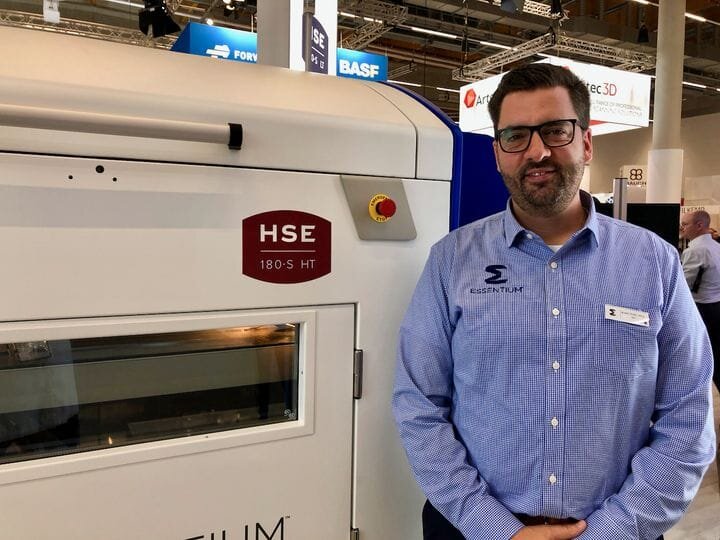![Blake Teipel, CEO of ESSENTIUM [Source: Fabbaloo]](https://fabbaloo.com/wp-content/uploads/2020/05/image-asset_img_5eb08c8f41ce9.jpg) Blake Teipel, CEO of Essentium [Source: Fabbaloo]
Blake Teipel, CEO of Essentium [Source: Fabbaloo]
We had a chat with Essentium’s CEO, Blake Teipel, to find out the latest developments with the upstart 3D printer manufacturer.
The company is now launching their products globally, and has apparently sold a number of devices already to eager customers.
Essentium Print Speed and Volume
![ESSENTIUM’s flagship 3D printer, the HSE 180•S [Source: Fabbaloo]](https://fabbaloo.com/wp-content/uploads/2020/05/image-asset_img_5eb08c8fa681c.jpg) Essentium’s flagship 3D printer, the HSE 180•S [Source: Fabbaloo]
Essentium’s flagship 3D printer, the HSE 180•S [Source: Fabbaloo]
Teipel is excited about the company’s latest machine, the HSE 180, which now comes in three variants, low temperature, standard and high temperature in the forms of the HSE 180•S LT, the HSE 180•S and the HSE 180•S HT. Each sport a rather large build volume of 740 x 510 x 650 mm.
![High quality 3D prints made at high speed by ESSENTIUM [Source: Fabbaloo]](https://fabbaloo.com/wp-content/uploads/2020/05/image-asset_img_5eb08c8fe681b.jpg) High quality 3D prints made at high speed by Essentium [Source: Fabbaloo]
High quality 3D prints made at high speed by Essentium [Source: Fabbaloo]
That huge build volume might be a problem for 3D printing larger objects due to the lengthy duration of the process, but Essentium has developed a method of 3D printing that is far faster than typical extrusion systems.
Teipel explained that Essentium has leveraged their prior knowledge in developing electronic chip-making equipment into 3D printing. Chip-making is a long-mature matter that has evolved a high-speed architecture. It’s that architecture that Essentium has borrowed for an entirely new application, 3D printing.
Teipel says by using high-quality linear motors and other premium components, combined with their own custom-written software, they are able to “unlock” the true capabilities of the hardware. He says they essentially “overclock the extrusion system”.
I’ve seen their extrusion system in action, and it indeed is incredibly fast, yet the parts produced are of a quality you’d expect to see from far slower extrusion systems.
Essentium Dual Extruder
![Control panel of the ESSENTIUM HSE 180•S 3D printer showing detailed realtime instrumentation [Source: Fabbaloo]](https://fabbaloo.com/wp-content/uploads/2020/05/image-asset_img_5eb08c90307ec.jpg) Control panel of the Essentium HSE 180•S 3D printer showing detailed real-time instrumentation [Source: Fabbaloo]
Control panel of the Essentium HSE 180•S 3D printer showing detailed real-time instrumentation [Source: Fabbaloo]
Teipel told us Essentium is set to introduce an independent extruder system in the near future, the “HSE 180•D”.
Independent extruders are an unusual feature found only on certain 3D printers these days. The idea is that each nozzle can move independently from the other, and that capability can be leveraged in different ways.
Typically you’ll see “IDEX” equipment provide the ability to 3D print two identical parts at the same time, or two different and separate parts at the same time. Some offer “mirror 3D printing”, where an identical object is printed with “left and right” versions on each side of the 3D printer.
All of these IDEX modes can in theory “double” your throughput, as they can produce two objects in the time that one would normally be made. But there’s something significant missing: the ability for the two nozzles to collaborate on 3D printing a single, large object. That could double the print speed, rather than merely the throughput.
Presumably this has not been a feature on other equipment because it must be extremely challenging to create software for collaborative 3D printing; collisions are constantly possible.
But Teipel explained to us that Essentium is working on collaborative dual extrusion software! If they succeed, this could be the only IDEX 3D printer capable of doing so, putting Essentium’s equipment at a level above most others.
Essentium 3D Printed Applications
We spent some time with Teipel trying to understand who’s buying their equipment, and it turns out they have some interesting clients.
One of their major clients is the semiconductor industry, who I would have not considered a major buyer of 3D printing gear. It turns out that the assembly process for electronic components is in desperate need of custom-made forms constantly.
![Electronic component tray application by ESSENTIUM [Source: Fabbaloo]](https://fabbaloo.com/wp-content/uploads/2020/05/image-asset_img_5eb08c9083ed7.jpg) Electronic component tray application by Essentium [Source: Fabbaloo]
Electronic component tray application by Essentium [Source: Fabbaloo]
The reason is that robotic assembly systems require supplies of components in fixed positions. Thus a manufacturer must produce some kind of “jig” that holds the components in place for a robot to grab them for installation.
![Electronic component tray application by ESSENTIUM [Source: Fabbaloo]](https://fabbaloo.com/wp-content/uploads/2020/05/essentium-tray-1_img_5eb08c90c93e3.jpg) Electronic component tray application by Essentium [Source: Fabbaloo]
Electronic component tray application by Essentium [Source: Fabbaloo]
As you might imagine, there are many different types of electronic components and thus a constant need for new jigs. These can easily be created with 3D printing, and particularly with Essentium’s high-speed devices.
![Flexible electronic component tray application by ESSENTIUM [Source: Fabbaloo]](https://fabbaloo.com/wp-content/uploads/2020/05/image-asset_img_5eb08c9125022.jpg) Flexible electronic component tray application by Essentium [Source: Fabbaloo]
Flexible electronic component tray application by Essentium [Source: Fabbaloo]
There’s an interesting twist to this application. Teipel explained that often the electronic components must be kept away from static electricity, otherwise they might get shorted out even before installation. For this Essentium provides a static-free material, and it’s even flexible to allow for easier robotic access.
Essentium Footwear
Another application area for Essentium is the footwear industry. Teipel told us they are working with clients to “shortcut the speed to mold process”. While some 3D printer companies have been experimenting with directly 3D printed midsoles, molding is still the traditional method of producing midsoles for footwear. However, the process of making the molds is cumbersome.
![Blow mold application made by ESSENTIUM [Source: Fabbaloo]](https://fabbaloo.com/wp-content/uploads/2020/05/image-asset_img_5eb08c916d94b.jpg) Blow mold application made by Essentium [Source: Fabbaloo]
Blow mold application made by Essentium [Source: Fabbaloo]
By transforming this mold-creation process to 3D printing, Essentium is able to dramatically speed up the process, saving the clients time and money. It will likely also enable footwear manufacturers to experiment with new styles as their turnaround time will be more rapid.
Via Essentium

